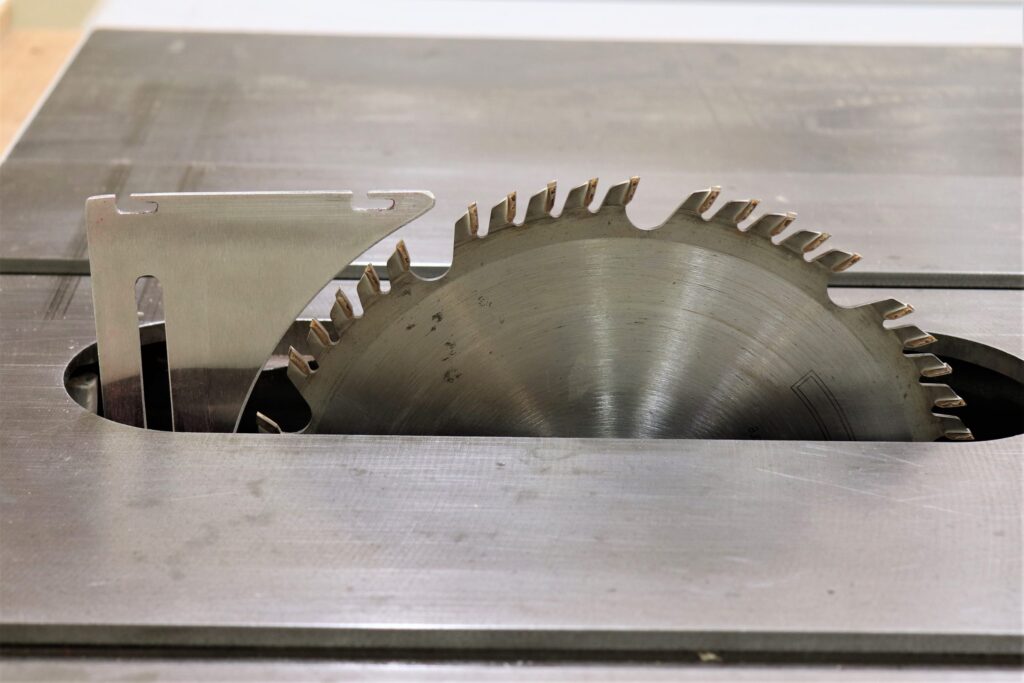When it comes to woodworking and DIY projects, safety should always be a top priority. One essential safety feature that often goes overlooked is the riving knife on a table saw.
However, if you’re new to woodworking or simply unfamiliar with this critical component, you’ve come to the right place. In this article, we’ll explore what a riving knife is, why it’s essential, and how it can make your woodworking experience safer and more efficient.
What Is a Riving Knife?
A riving knife is a thin, flat, and often metal blade mounted just behind the saw blade on a table saw. It is designed to move up and down with the saw blade, remaining in close proximity to the blade during cuts.
Furthermore, the primary purpose of a riving knife is to prevent kickback, which is a sudden, powerful, and dangerous reaction that can occur when a workpiece binds or pinches between the saw blade and the fence. Kickback can lead to severe injuries and damage to your woodworking equipment.
What Are The Key Features Of a Riving Knife?
A riving knife is an important safety feature found on many table saws, and it serves several key functions to enhance the safety and performance of the tool. Here are the key features and functions of a riving knife.
Alignment with the Saw Blade: A riving knife is aligned with the saw blade, ensuring that it follows the same cutting path. This close alignment is crucial for preventing binding and kickback.
Height Adjustment: The riving knife can usually be adjusted in height to match the thickness of the material you’re cutting. This ensures that it remains effective for a variety of cuts.
Attachment to the Saw: The riving knife is securely attached to the saw’s arbor assembly or trunnion, which ensures it moves in sync with the blade.
Splitter and Anti-Kickback Pawls: Some riving knives have integrated splitters and anti-kickback pawls. These additional safety features provide even more protection against kickback incidents.
Why Is a Riving Knife Essential?
Now that we know what a riving knife is, it’s essential to understand why it’s a crucial component on a table saw. Here are some compelling reasons:
Kickback Prevention
The primary function of a riving knife is to prevent kickback. By maintaining alignment with the saw blade, it prevents the workpiece from binding and getting pinched between the blade and the fence. This reduces the risk of the material being violently ejected back towards the operator.
Enhanced Safety
Riving knives enhance the overall safety of using a table saw. They minimize the chances of injuries by reducing the potential for accidents and mishaps.
Compliance with Safety Standards
In many regions, safety standards and regulations mandate the use of riving knives or similar devices on table saws. Compliance with these regulations is not just a matter of safety; it’s also a legal requirement in some cases.
Better Cutting Performance
A riving knife not only improves safety but also contributes to the quality of your cuts. It helps prevent the material from binding, ensuring smoother and more precise cuts.
Reduced Material Waste
Kickback incidents can lead to significant material waste as the workpiece is damaged or thrown off course. A riving knife minimizes such waste by preventing these incidents.
What Are The Proper Usages of a Riving Knife?

To make the most of a riving knife, it’s essential to use it correctly. Here are some tips for proper usage:
Keep It Aligned: Always ensure that the riving knife is correctly aligned with the saw blade. Misalignment can render it ineffective in preventing kickback.
Adjust Height: For different cuts and material thicknesses, adjust the height of the riving knife so that it remains just slightly above the workpiece.
Maintain Sharpness: Inspect the riving knife regularly to ensure it’s sharp and in good condition. Dull or damaged riving knives may not perform effectively.
Use Other Safety Features: If your riving knife has integrated splitters and anti-kickback pawls, use them in conjunction with the riving knife for enhanced safety.
Learn Proper Techniques: Lastly, it’s essential to learn proper table saw techniques, such as maintaining a consistent feed rate and using a push stick when necessary, to further reduce the risk of accidents.
Conclusion
A riving knife is an indispensable safety feature on a table saw. It prevents kickback, enhances safety, and ensures a better woodworking experience. Whether you’re a seasoned woodworker or just starting, always use a riving knife when operating a table saw.
In addition, it’s a simple yet effective tool that can make a significant difference in your safety and the quality of your woodworking projects. Remember, when it comes to table saws, safety should always be a top priority.
